It’s a Cascade of 14nm CPUs: AnandTech’s Intel Core i9-10980XE Review
by Dr. Ian Cutress on November 25, 2019 9:00 AM ESTGaming: Grand Theft Auto V
The highly anticipated iteration of the Grand Theft Auto franchise hit the shelves on April 14th 2015, with both AMD and NVIDIA in tow to help optimize the title. GTA doesn’t provide graphical presets, but opens up the options to users and extends the boundaries by pushing even the hardest systems to the limit using Rockstar’s Advanced Game Engine under DirectX 11. Whether the user is flying high in the mountains with long draw distances or dealing with assorted trash in the city, when cranked up to maximum it creates stunning visuals but hard work for both the CPU and the GPU.
For our test we have scripted a version of the in-game benchmark. The in-game benchmark consists of five scenarios: four short panning shots with varying lighting and weather effects, and a fifth action sequence that lasts around 90 seconds. We use only the final part of the benchmark, which combines a flight scene in a jet followed by an inner city drive-by through several intersections followed by ramming a tanker that explodes, causing other cars to explode as well. This is a mix of distance rendering followed by a detailed near-rendering action sequence, and the title thankfully spits out frame time data.
There are no presets for the graphics options on GTA, allowing the user to adjust options such as population density and distance scaling on sliders, but others such as texture/shadow/shader/water quality from Low to Very High. Other options include MSAA, soft shadows, post effects, shadow resolution and extended draw distance options. There is a handy option at the top which shows how much video memory the options are expected to consume, with obvious repercussions if a user requests more video memory than is present on the card (although there’s no obvious indication if you have a low end GPU with lots of GPU memory, like an R7 240 4GB).
All of our benchmark results can also be found in our benchmark engine, Bench.
| AnandTech | IGP | Low | Medium | High |
| Average FPS | 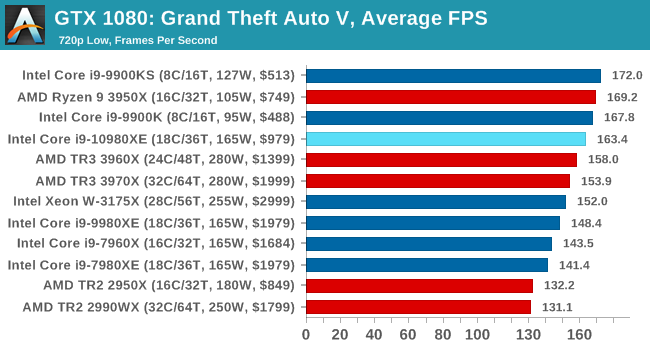 |
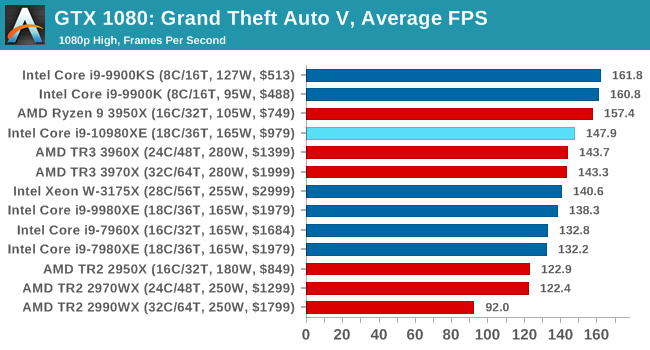 |
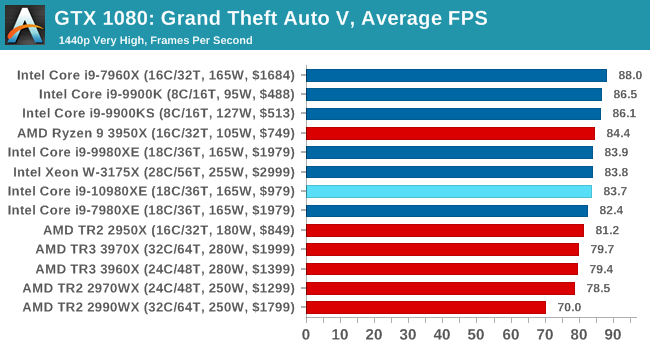 |
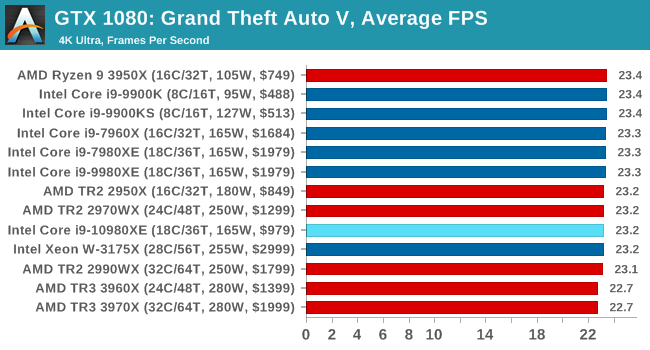 |
| 95th Percentile | 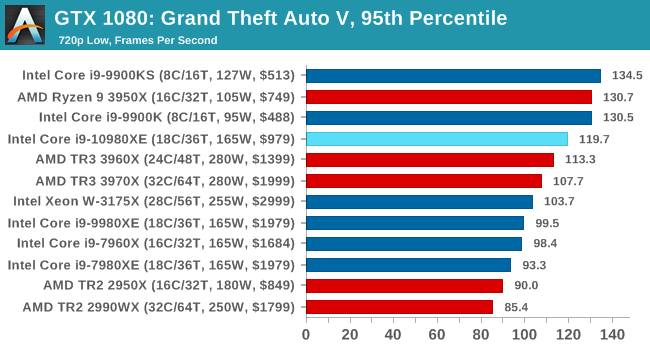 |
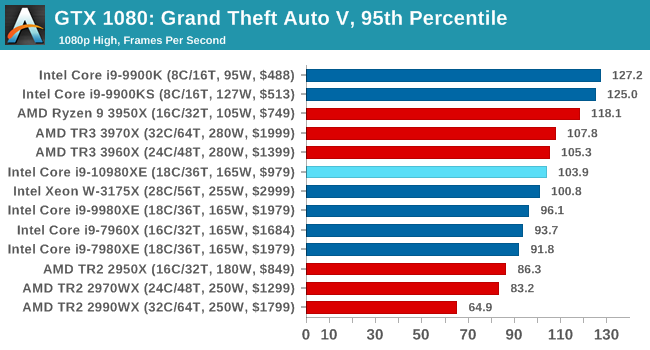 |
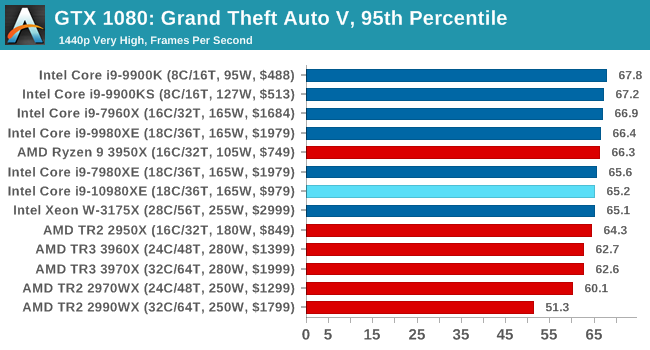 |
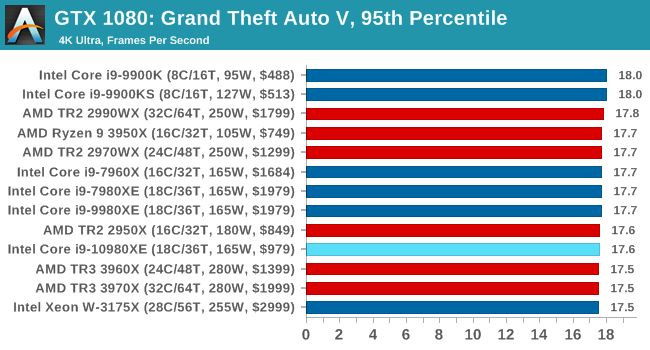 |


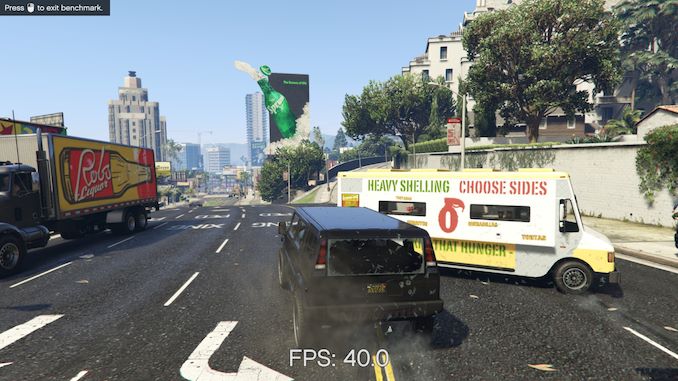









79 Comments
View All Comments
milkywayer - Monday, November 25, 2019 - link
Thank you AMD for strong arming the serial-milker Intel. Price cut from $1900 to $900. Hard to believe Intel would cut down on the core count milking. Am I dreaming?regsEx - Monday, November 25, 2019 - link
Mind it was Intel and without any competition who lowered mainstream price from $500 to $300 back in 2011. 3700X would cost $500 now if not that. So thank you, Intel.Spunjji - Monday, November 25, 2019 - link
Balderdash. Near the end of 2010 you could get a 6-core AMD Phenom II CPU for $270. By 2011, an "8 core" 4-module Bulldozer cost the same and Intel's products were priced to compete with that.So, uh, thanks again AMD..?
karmapop - Monday, November 25, 2019 - link
Sorry, but you may want to dig back into the review archives for some untinted perspective on that info. In fact, you're both incorrect. That mainstream performance pricing shift happened in 2008, with the introduction of the Yorkfield Core 2 Quad chips, and more importantly the Bloomfield Core i7 (with the i7-920 becoming that $300 darling entry point for the enthusiast platform).Those mid-2010 Thuban Phenom II X6 chips? Passably competitive with the lowest end quad-core Bloomfield chips (which were already on the market for a year and a half prior). And let's just forget about the dumpster fire that was Bulldozer, given that fabled FX-8150 had trouble matching the old Thuban Phenom II X6 at launch.
nt300 - Tuesday, November 26, 2019 - link
The FX 8350 & FX 8320 Piledriver CPUs saved AMDs bacon and proved to be more than enough for modern PC Gaming back in the day. They held great price/performance and were highly cost effective. Among Steamroller, then Excavator for the APU markets, they've held AMD afloat just in time for the superior ZEN launch. Now sit back and watch Intel finally struggle, deservingly so.yeeeeman - Wednesday, November 27, 2019 - link
They were so crap that AMD could boast 50% better ipc with zen over bulldozer, while still being lower than Skylake.Korguz - Wednesday, November 27, 2019 - link
too bad zen has better ipc then intel now...Gondalf - Wednesday, November 27, 2019 - link
According to the official Spec submissions nope, Zen 2 is on pair with Skylake (bypassing the huge L3). More or less AMD enlarged the L3 just to have the lead, this have a cost obviously, the 7nm silicon is pretty expensive. Try to image a 9900K with 32MB of L3 with the same latency.You will have a winner.
Korguz - Wednesday, November 27, 2019 - link
gondalfsorry but zen 2 does have better ipc then intel does now.. why else does intel need such high clocks to compete with lower clocked chips ?? explain that one.. clock for clock.. zen 2.. has better ipc...
Qasar - Wednesday, November 27, 2019 - link
gondalf : According to the official Spec submissions " what spec submissions page ? also.. if you think having a large L3 cache is the reason why zen has more ipc then intel, then there is something wrong. if that was the case, WHY didnt intel do the same with the 10xxx series they just released ? keep in mind, 10xxx series, as 10 megs more of L2 to play around with... lets see you explain that as well.